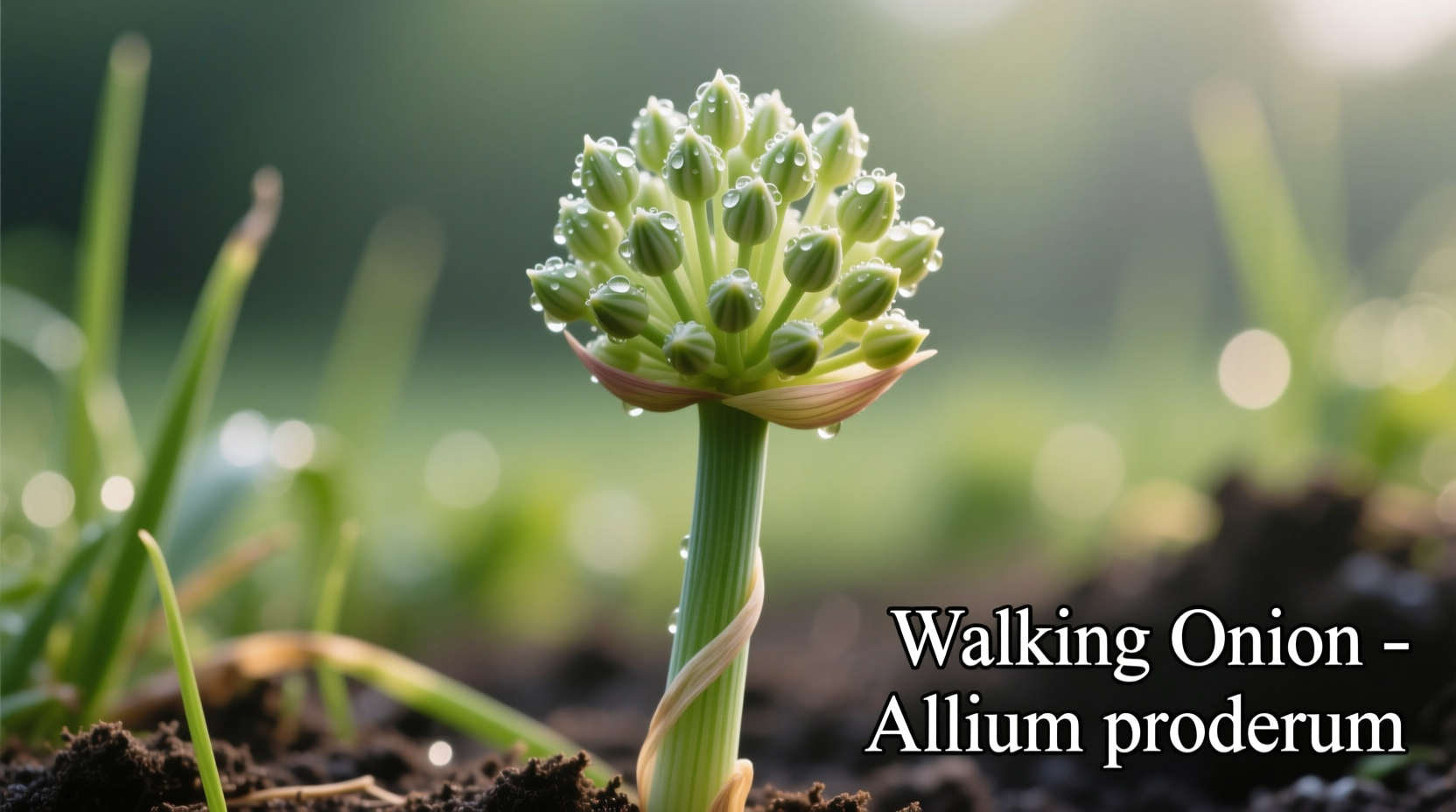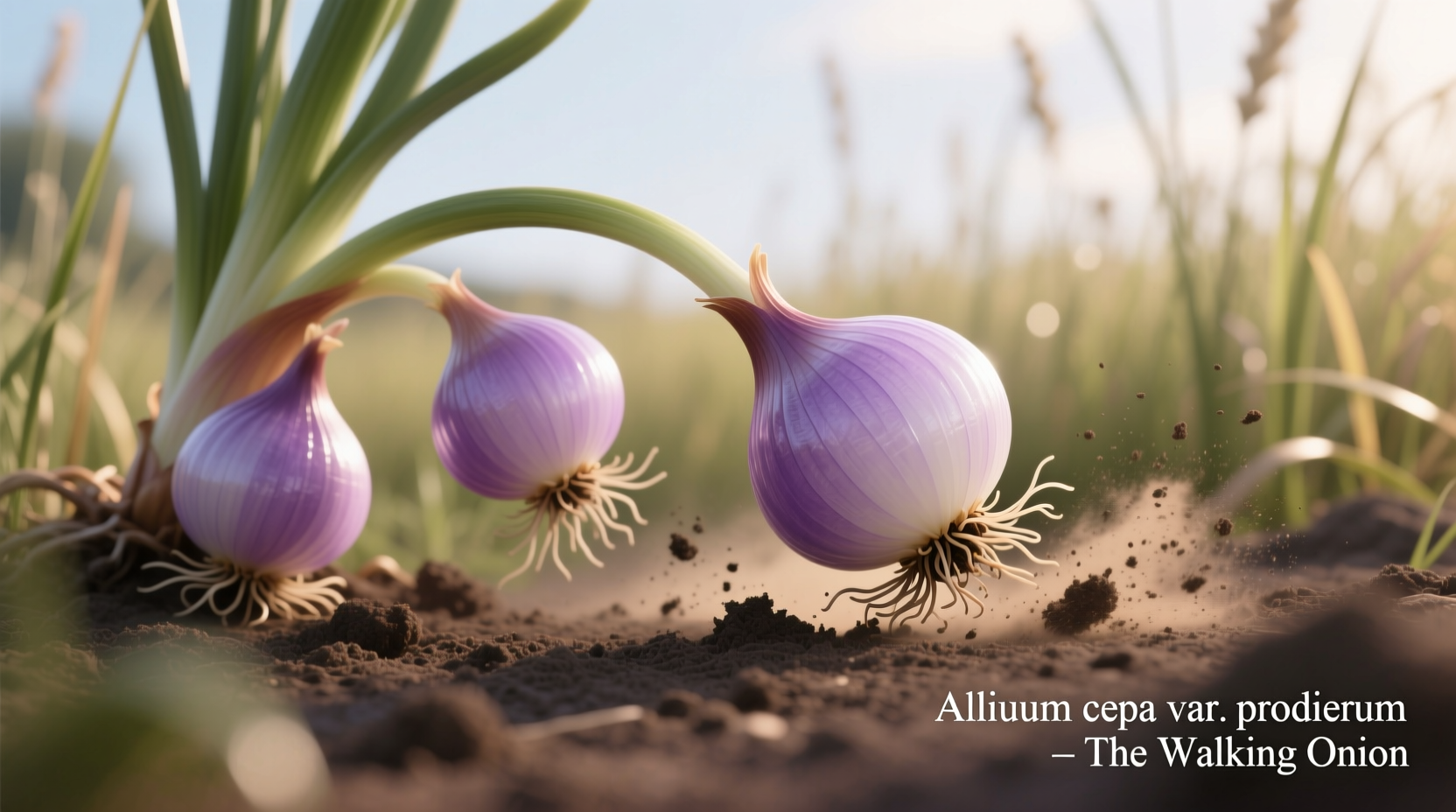Discover why walking onion bulbs are becoming a staple in sustainable gardens across North America and Europe. Unlike traditional onions that require annual planting, these remarkable alliums return reliably each season, offering continuous harvests of flavorful greens and small bulbs. Gardeners appreciate their resilience—they thrive in USDA zones 3-9 with minimal care, resist most pests, and provide three edible components: the underground bulbs, the green stalks, and the distinctive top bulblets.
What Makes Walking Onion Bulbs Unique?
Walking onions (Allium proliferum) represent one of nature's cleverest propagation strategies among edible plants. While most onions flower and set seed, walking onions produce clusters of small bulblets at the top of their stalks. As these bulblets mature and gain weight, they bend the stalk toward the soil. Once they touch the ground, they take root and form new plants—literally "walking" across your garden bed over time.
This distinctive growth pattern creates a natural succession of plants. In spring, you'll harvest the previous year's underground bulbs. By midsummer, the new bulblets begin forming at the top of the stalks. By fall, those bulblets have rooted and started their own growth cycle. This continuous production makes walking onions exceptionally productive per square foot of garden space.

Planting Your Walking Onion Bulbs: Timing and Technique
The optimal time to plant walking onion bulbs depends on your climate zone. In colder regions (zones 3-5), plant in early spring as soon as the soil can be worked, or in late summer for establishment before winter. Warmer climates (zones 6-9) benefit from fall planting, which allows roots to establish during cooler months.
Follow these planting steps for success:
- Choose a location with full sun (6+ hours daily) and well-draining soil
- Plant bulbs 1-2 inches deep and 6 inches apart
- Water thoroughly after planting, then maintain consistent moisture until established
- Apply 2-3 inches of mulch to regulate soil temperature and moisture
Walking onions tolerate various soil types but perform best in loamy soil with pH between 6.0-7.5. Unlike annual onions, they don't require rich soil—excessive nitrogen can actually reduce bulblet production.
Seasonal Growth Timeline: How Walking Onions "Walk"
Understanding the annual cycle of walking onions helps maximize your harvests. Here's what happens throughout the year:
- Early Spring: Overwintered plants send up green shoots; underground bulbs reach harvest size
- Late Spring: Stalks grow taller (3-4 feet), developing characteristic bulblets at the top
- Midsummer: Bulblets mature and gain weight, bending stalks toward soil
- Late Summer: Bulblets touch soil and begin rooting; new plants establish
- Fall: New plants grow vigorously before winter dormancy
- Winter: Established plants survive freezing temperatures; new plants go dormant
This continuous cycle means your walking onion patch naturally expands each year. To control spread, simply harvest the bulblets before they bend to the ground, or trim the flower stalks when bulblets reach pea-size.
Harvesting All Three Edible Components
Walking onions offer triple harvest potential throughout the growing season:
- Green tops: Snip as needed like chives from early spring through fall (best before bulblets form)
- Underground bulbs: Harvest in late spring when tops begin to yellow (smaller than grocery store onions but intensely flavorful)
- Top bulblets: Harvest in midsummer when firm and purple-tinged (excellent for pickling or planting)
For continuous green onion production, never harvest more than one-third of the tops at once. The underground bulbs develop their full flavor after 2-3 years of growth, becoming more substantial each season. Top bulblets can be eaten fresh, pickled, or stored for planting next season.
| Feature | Walking Onions | Regular Onions |
|---|---|---|
| Lifespan | Perennial (returns yearly) | Annual (must replant) |
| Propagation | Bulblets at stalk top | Seeds or sets |
| Cold Hardiness | USDA zones 3-9 | Most zones 5-10 |
| Harvest Components | Tops, bulbs, bulblets | Primarily bulbs |
| Maintenance | Low (once established) | Moderate to high |
Climate Considerations and Growing Limits
While remarkably adaptable, walking onions have specific climate preferences that affect their performance. According to USDA agricultural research, they thrive best in temperate climates with distinct seasons. In extremely hot regions (zones 9-10), they may struggle with summer heat and require partial shade.
Walking onions need a winter chilling period to perform optimally—typically 8-10 weeks below 45°F (7°C). In mild winter climates, they may produce fewer bulblets. Gardeners in southern states often report better results when planting in partial shade with consistent moisture during hot months.
Soil drainage proves critical in rainy climates. The USDA Natural Resources Conservation Service notes that walking onions suffer in waterlogged conditions, making raised beds ideal in regions with heavy rainfall. Their shallow root system also makes them excellent candidates for container gardening, which provides better soil control.
Culinary Applications for All Parts
Walking onions deliver a complex flavor profile that varies by component. The green tops offer a mild, chive-like flavor perfect for garnishes and salads. Underground bulbs provide a stronger, more pungent taste similar to shallots, while the top bulblets deliver the most intense onion flavor—ideal for pickling or adding punch to dishes.
Professional chefs value walking onions for their extended harvest window. Unlike regular onions that have a limited fresh season, walking onions provide edible greens from early spring through fall. The top bulblets, harvested in midsummer, offer a unique texture and concentrated flavor that works beautifully in:
- Pickled vegetables (they maintain crispness better than regular onions)
- Stir-fries (add just before serving for maximum flavor impact)
- Compound butters (combine with herbs for instant flavor boost)
- Roasted vegetable medleys (the small size cooks evenly)
Long-Term Storage Techniques
Proper storage extends your walking onion harvest through winter. Underground bulbs store similarly to regular onions but are smaller, so they don't last quite as long. Cure bulbs for 2-3 weeks in a dry, well-ventilated space before storing.
For maximum storage life:
- Store cured bulbs in mesh bags in a cool (32-40°F), dark place with 65-70% humidity
- Top bulblets keep best when pickled (last 6-12 months)
- Freeze chopped green tops in ice cube trays with water or oil
- Dry green tops for use as onion powder (less flavorful but functional)
Unlike grocery store onions that often sprout prematurely, properly stored walking onion bulbs maintain quality for 3-4 months. The top bulblets, when pickled according to National Center for Home Food Preservation guidelines, remain crisp and flavorful for up to a year.
Troubleshooting Common Growing Issues
Walking onions prove remarkably resilient but may encounter these issues:
- Reduced bulblet production: Usually indicates excessive nitrogen or insufficient sunlight. Reduce fertilization and ensure 6+ hours of direct sun.
- Yellowing leaves: Can signal overwatering or poor drainage. Amend soil with compost and consider raised beds.
- Pest damage: Rare but possible. Onion maggots occasionally affect young plants—use row covers during vulnerable stages.
- Excessive spreading: Harvest bulblets before they touch soil, or install root barriers around the planting area.
Unlike many garden plants, walking onions rarely suffer from diseases when grown in appropriate conditions. Their perennial nature means they develop stronger resistance each year, making them an increasingly reliable crop with minimal intervention.











 浙公网安备
33010002000092号
浙公网安备
33010002000092号 浙B2-20120091-4
浙B2-20120091-4